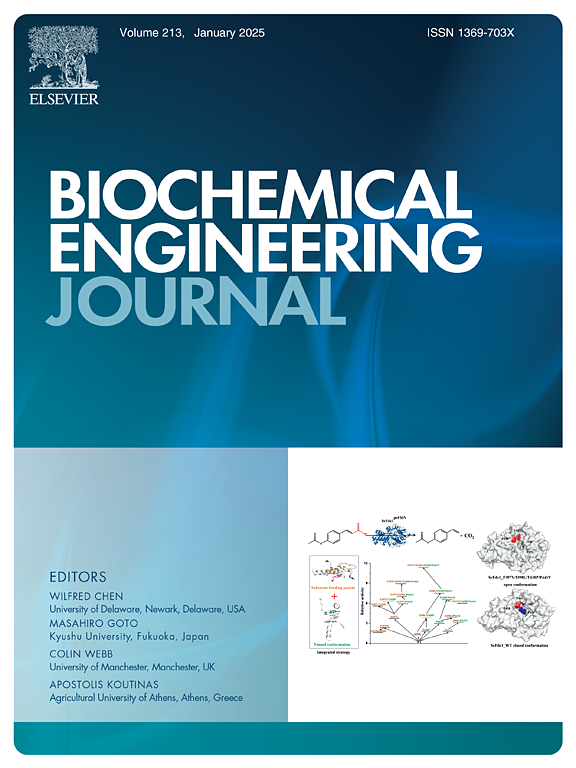Insights into the response and tolerance mechanisms of Papiliotrema laurentii to acetic acid stress by RNA-seq and genome-scale metabolic modeling analysis
IF 3.7
3区 生物学
Q2 BIOTECHNOLOGY & APPLIED MICROBIOLOGY
引用次数: 0
Abstract
Lipid production by oleaginous yeasts from lignocellulosic biomasses is a sustainable alternative to produce oleochemicals; nevertheless, the pretreatment of these biomasses releases yeast inhibitors, including acetic acid. Papiliotrema laurentii UFV-1 converts lignocelulose-derived sugars into high lipid contents; however, wild strains are sensitive to acetic acid. Previously, our group selected an acetic acid-tolerant strain of P. laurentii (ATS) by Adaptive Laboratory Evolution and identified mutations that might contribute to its tolerance. Here, we combined transcriptome, metabolic modeling and protein-protein interaction analyses to deepen our understanding about acetic acid stress targets and adaptive responses in P. laurentii. Acetic acid stress promoted global expression changes; most of them related to transcription, translation, and ribosome biogenesis. Under acetic acid stress, the sensitive strain induced DNA mismatch repair and meiosis, while the tolerant strain negatively regulated autophagy and cell cycle. The tolerant strain induced processes related to increasing intracellular pH, detoxification, and proton efflux. Importantly, ATS presented a remarkable NAD(P)H pool in the metabolic modeling analysis, which might support the reducing power required by tolerance mechanisms. Meanwhile, the sensitive strain induced genes related to cell wall biogenesis, consistent with its morphological changes described in our previous study. The pathways described as tolerant-related might be used in metabolic engineering strategies to improve the tolerance of P. laurentii to weak acids, boosting its application in lignocellulosic biorefineries.
通过RNA-seq和基因组尺度代谢模型分析,深入了解laurentii Papiliotrema对乙酸胁迫的反应和耐受机制
产油酵母从木质纤维素生物质中生产油脂是一种可持续的生产油脂化学品的替代方法;然而,预处理这些生物质释放酵母抑制剂,包括乙酸。laurentii Papiliotrema uv -1将木质纤维素衍生的糖转化为高脂质含量;然而,野生菌株对醋酸敏感。在此之前,我们的研究小组通过适应性实验室进化选择了一株耐乙酸的劳伦氏p.l arentii (ATS)菌株,并鉴定了可能有助于其耐受性的突变。在此,我们结合转录组学、代谢模型和蛋白相互作用分析来加深我们对P. laurentii醋酸胁迫靶点和适应性反应的理解。醋酸胁迫促进了整体表达的变化;其中大多数与转录、翻译和核糖体生物发生有关。在醋酸胁迫下,敏感菌株诱导DNA错配修复和减数分裂,而耐受性菌株负向调节自噬和细胞周期。耐药菌株诱导的过程与细胞内pH值增加、解毒和质子外排有关。重要的是,ATS在代谢模型分析中呈现出显著的NAD(P)H库,这可能支持耐受机制所需的还原力。同时,敏感菌株诱导的细胞壁生物发生相关基因与我们前期研究中描述的细胞壁形态变化一致。这些被描述为耐受性相关的途径可能用于代谢工程策略,以提高P. laurentii对弱酸的耐受性,促进其在木质纤维素生物炼制中的应用。
本文章由计算机程序翻译,如有差异,请以英文原文为准。
求助全文
约1分钟内获得全文
求助全文
来源期刊

Biochemical Engineering Journal
工程技术-工程:化工
CiteScore
7.10
自引率
5.10%
发文量
380
审稿时长
34 days
期刊介绍:
The Biochemical Engineering Journal aims to promote progress in the crucial chemical engineering aspects of the development of biological processes associated with everything from raw materials preparation to product recovery relevant to industries as diverse as medical/healthcare, industrial biotechnology, and environmental biotechnology.
The Journal welcomes full length original research papers, short communications, and review papers* in the following research fields:
Biocatalysis (enzyme or microbial) and biotransformations, including immobilized biocatalyst preparation and kinetics
Biosensors and Biodevices including biofabrication and novel fuel cell development
Bioseparations including scale-up and protein refolding/renaturation
Environmental Bioengineering including bioconversion, bioremediation, and microbial fuel cells
Bioreactor Systems including characterization, optimization and scale-up
Bioresources and Biorefinery Engineering including biomass conversion, biofuels, bioenergy, and optimization
Industrial Biotechnology including specialty chemicals, platform chemicals and neutraceuticals
Biomaterials and Tissue Engineering including bioartificial organs, cell encapsulation, and controlled release
Cell Culture Engineering (plant, animal or insect cells) including viral vectors, monoclonal antibodies, recombinant proteins, vaccines, and secondary metabolites
Cell Therapies and Stem Cells including pluripotent, mesenchymal and hematopoietic stem cells; immunotherapies; tissue-specific differentiation; and cryopreservation
Metabolic Engineering, Systems and Synthetic Biology including OMICS, bioinformatics, in silico biology, and metabolic flux analysis
Protein Engineering including enzyme engineering and directed evolution.
 求助内容:
求助内容: 应助结果提醒方式:
应助结果提醒方式:


